This deliciously sour cucumber soup (zupa ogórkowa) is a traditional Polish dish, very popular in Poland. The soup is quite unlike any soup you’ve ever tasted, with a unique flavor that’s very fresh and refreshing.
It’s an easy-to-make recipe but it requires brined cucumbers (i.e., cucumbers preserved in water with garlic, dill and spices), NOT the ones pickled in vinegar. It is this brine that makes the soup special. The process of natural fermentation in brine is how the cucumbers develop their sour taste – no vinegar is involved.
Now I promise it’s not what you think. The tanginess of the pickles combined with cream and fresh dill gives it a very refreshing flavor, making it a perfect recipe for a spring or summer meal.
In any case, I urge you to try the Polish cucumber soup and post a comment to let me know what you think.
Polish Cucumber Soup
Ingredients:
- 6 cups of water
- 1 onion, diced or 1 medium leek, white and light-green parts, rinsed well, then cut into 1/2-inch pieces
- 2-3 garlic cloves, minced
- 2 large carrots (peeled and finely diced)
- 1 parsnip (peeled, trimmed and finely diced), optional
- 1/2 medium celery root (celeriac), peeled and finely diced, or 2 celery stalks, trimmed; chopped into 1/2-inch pieces
- 2 potatoes (peeled and cubed)
- 8 large pickled cucumbers (pickled in brine as opposed to vinegar)
- 2 tablespoons Earth Balance or other vegan margarine (optional)
- A handful of fresh dill
- 1/4 cup of raw cashews (optional)
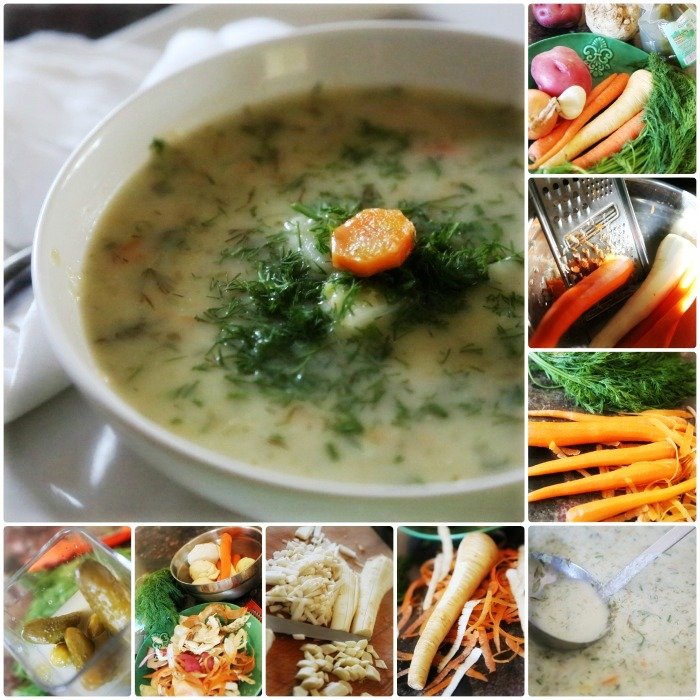
Method:
- Place onion and garlic in a large stock pot and cook for 2-3 minutes in 2-3 tablespoons of water.
- Add 5 cups water, a bay leaf, and bring to a boil. Once boiling, reduce the heat and allow to cook for around 15 minutes, or until all the vegetables are cooked. You may add some pepper, but I wouldn’t add any salt at this point, as the brine is quite salty on its own.
- Meanwhile, grate or process (but not too finely) the pickles. In traditional recipes, the cucumbers are peeled, grated and fried in butter before being added to the pot. You can do that by using vegan butter substitute, such as Earth Balance. What you can do, instead, is just blend the cucumbers whole in brine in my Vitamix. I used all of the cucumbers and all of the brine from the package. I like to add quite a lot of the brine to the soup as I really loved the sour taste, but you may choose to add a little less and see how you like it first. Add the grated or blended pickles (including the juice) to the soup.
- Now, make the cashew cream (this is the secret ingredient to cholesterol-free creamy soups, such as this cream of asparagus or cream of celeriac soup). In the Vitamix, blend the cashews with 1 cup water on high until very smooth. Add to the soup.
- Taste the soup and adjust the flavors to your liking. The soup should have a pleasantly sour taste. If you saved part of the dill pickle juice/brine and you want the soup to be more sour, add some more brine to the soup. If you want a thinner soup, add a little water. Mash or blend some potatoes and veggies if you want a thicker soup.
- Ladle your soup into your serving bowl and garnish with a sprinkling of fresh dill. Serve with a piece of crusty bread.
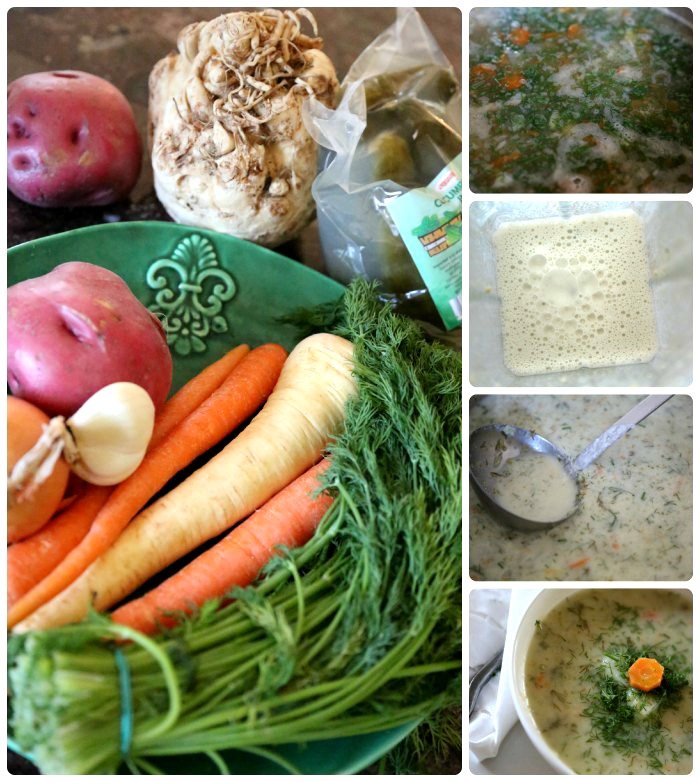
This works better if you use homemade sour pickles, but good sour dill pickles will do.
When I was growing up, brined cucumbers were always present in my home. My father used to make them in the summer when fresh cucumbers are readily available (with lots of dill and garlic; in Polish these are called ogórki kiszone, in English often referred to as Polish dill pickles). We would save some in jars for winter, but we also used to buy them at the farmer’s market from a wooden barrel.
If you have a Polish store in your neighborhood, you can try to find Krakus brand, but others will do just fine. In New Jersey, where I live right now, there is a big Polish population, so you can find them in many stores. Even my farmer’s market sells them in brine from a big wooden barrel.

This cucumber soup is a great make-ahead dish. The soup (minus the dill) can be refrigerated for up to 3 days.

For all my blending recipes I use Vitamix. If you don’t already own a VitaMix, I strongly encourage you to check out what this machine is capable of! For more information about VitaMix you can go directly to the VitaMix website. You may also want to read my post about the Best Blender.
I LOVE my VitaMix and highly recommend investing in one if you are ready to make serious changes to your diet. I have had mine for almost 5 years and use it daily!
If you decide to purchase Vitamix – be sure to use Promotional Code 06-004554 to get free shipping.
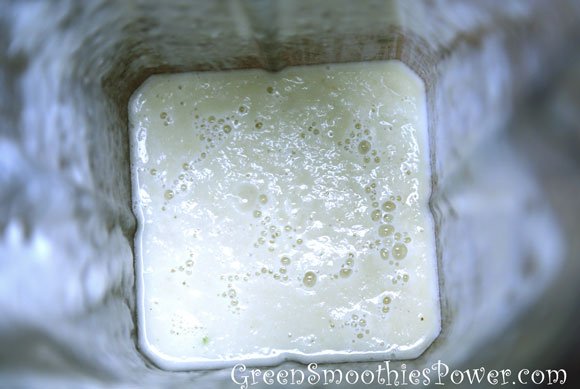
The Making of Cream of Celery Soup: Inside of my Vitamix
Questions? Comments? Suggestions?
If you have a favorite recipe, why not submit it here in the comment section of this smoothie recipes blog for others to enjoy too!
I also welcome any comments, questions and suggestions. Thanks!
I’ve been experimenting lately with easy, no-bake desserts, such as chocolate mousse with tofu and chocolate mousse with avocado. Since I had a bag of frozen strawberries and a package of silken tofu, I thought “Why not try this combination?”
Turns out, this strawberry-tofu combination produces another winning dessert (or snack) that’s rich in protein and low in sugar.
Here is what you’ll need:
Strawberry Mousse Recipe
1/2 cup tofu, silken, firm or extra-firm
1/3 cup strawberries, fresh or frozen
2 tablespoons agave nectar (or to taste)
1 teaspoon fresh lemon juice (orange juice can be used too)
a dash of vanilla extract
a dash of salt (optional)

Blend all ingredients until very smooth in a blender, food processor, or using a hand blender. Refrigerate for at least two hours or until chilled and transfer to a serving bowl or individual dishes. Serve topped or layered with more strawberries and garnished with chocolate curls, or let your imagination run wild. Makes 2 servings.
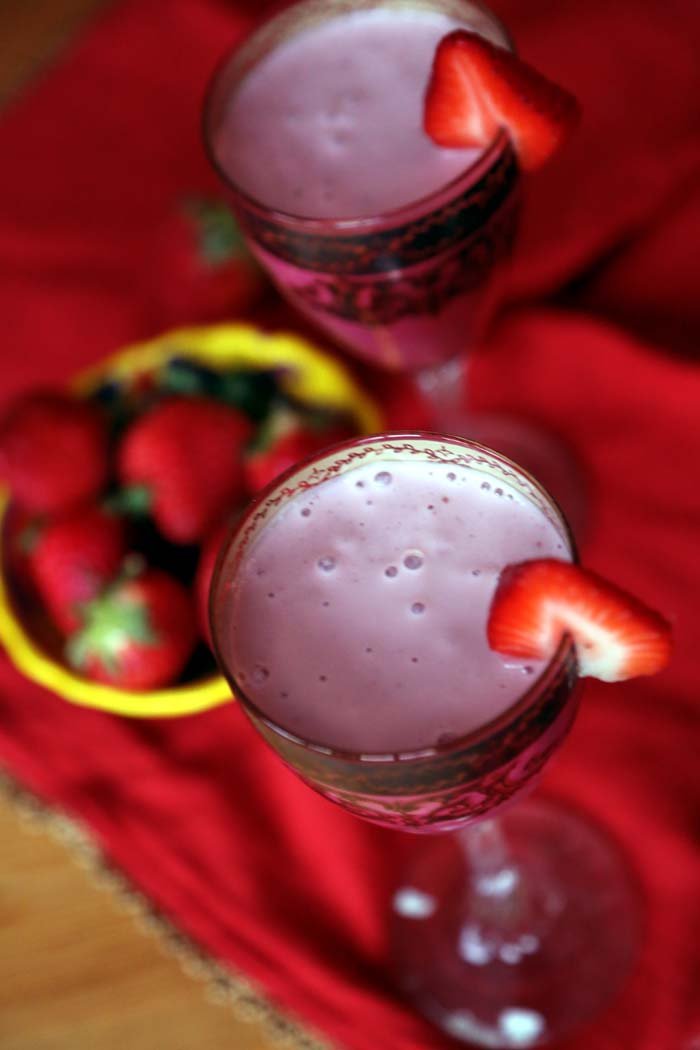
Note: You can reduce the sugar even further in this recipe by reducing agave nectar or substituting it with stevia (the herb).

Many mousse recipes that you will find online contain lots of eggs and heavy cream. This recipe contains neither, resulting in a much healthier desert (for humans, but especially for hens and cows).
On its own, silken tofu has almost no flavor (or, tastes slightly chalky, depending on the variety and whom you ask;-)), but blended (or cooked) with flavorful ingredients, it can take on a myriad of flavors.
By the way, you might have read various scare articles on the Internet about soy (usually based on misleading articles from the Weston A. Price Foundation) but they’re misinterpretations of science. Soy is a healthy food, just like other beans and legumes, and most people can eat it safely (some people are allergic to it). I eat soy in moderation and try for whole soy in natural forms (tofu, tempeh, soy milk). Just make sure you buy organic or GMO-Free soy products.

I added a splash of soy milk into my blender, which resulted in less thick dessert than I would like, but it was still delicious.
Although the pumpkin and cinnamon flavorings are generally associated with autumn, they made for an excellent two-day muffin party in February. Last week, I created a batch of these delicious, healthy treats for my house… and they disappeared shortly thereafter.
Filled with cholesterol-reducing organic oats (I bought as organic as possible to get the best results), the multifaceted superfood flax, and mixed with almond milk, containing plenty of calcium and vitamin E, these were an amazing combination. They also contain cinnamon, which has its own benefits on top of being tasty, like regulating blood flow and circulation.
They tasted perfect, were extremely moist, and were an ideal meeting of a few of my favorite qualities in food: sweetness (but not too sweet) and nourishment.
This recipe makes 12 muffins, and you can play around and add or subtract or modify as you see fit. I made mine on the thicker side, with more oats for texture, but you can use the recommended amount below if you like a lighter muffin.
Cinnamon Pumpkin Muffins Recipe: Simply Delicious and Oh-So-Good-For-You
Ingredients
-
- 1 1/2 cups whole wheat flour
-
- 1/2 cup old fashion oats (more for topping)
-
- 1/2 cup raw sugar
-
- 3 teaspoons cinnamon
-
- 1 teaspoon baking powder
-
- 1/2 teaspoon baking soda
-
- 1/4 teaspoon salt
-
- 1 1/2 cup pumpkin puree
-
- 1 flax egg-replacement (1 tablespoon flax meal, 2 1/2 tablespoons water)
-
- 2 tablespoons extra virgin olive oil
-
- 1 cup almond milk
-
- 1 teaspoon vanilla extract
Instructions
- Fold a paper towel and add a drop of oil, then prime the muffin pan. Warm oven to 375F.
- Mix the flax egg in a large bowl. Combine almond milk, pumpkin, oil, vanilla extract, and raw sugar to the same bowl.
- Delicately combine flour, baking soda, baking powder, cinnamon and salt in a sifter and add to wet ingredients, then whisk together until well blended.
- Spoon batter into muffin pan until each cup is filled to the top. (Go just above if you want larger muffins.) Add oats to the tops if desired.
- Bake for 20-25 minutes (depending on oven power and batter thickness - mine took 25) or until golden brown and a toothpick comes out clean.
- Allow to cool and store in air-tight glass or plastic.
3.1
https://greenreset.com/vegan-cinnamon-pumpkin-muffins/
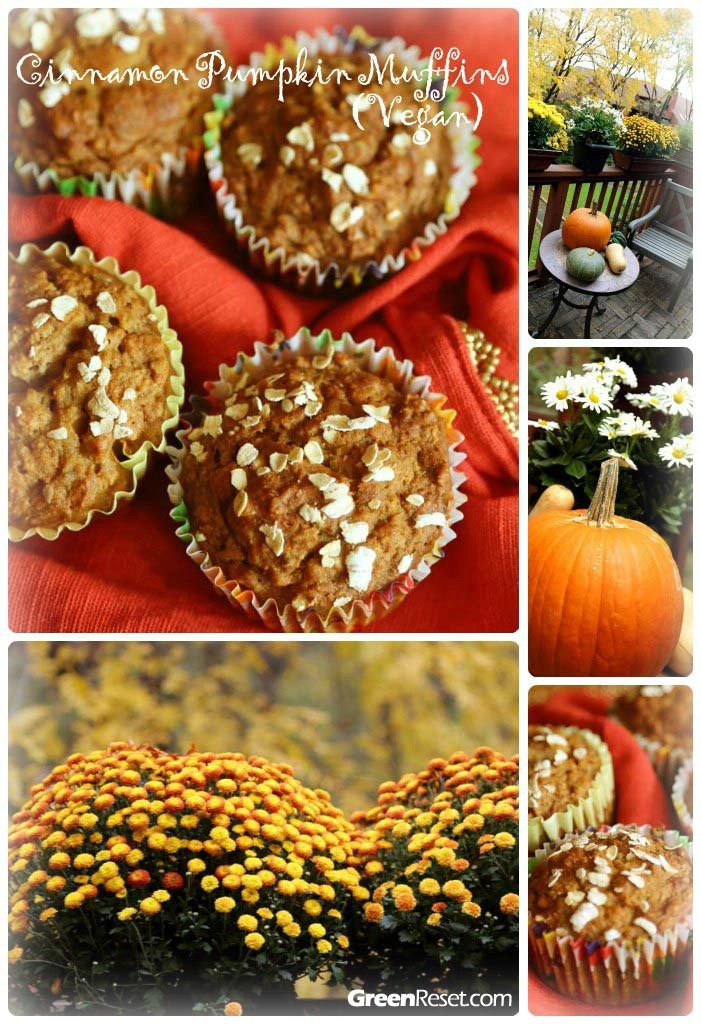

Although the pumpkin and cinnamon flavorings are generally associated with autumn, they made for an excellent two-day muffin party in February.
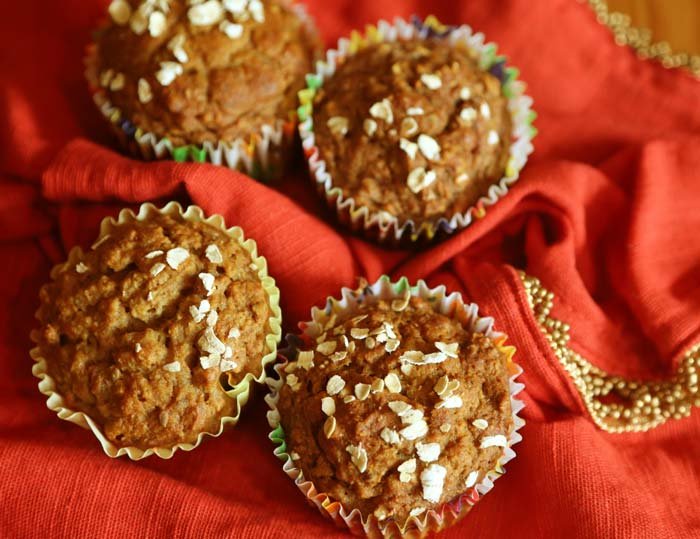
Cinnamon Pumpkin Muffins: Simply Delicious
This guest post is provided by echealthinsurance.com/wellness/eat-well/recipes/. Visit their website to absorb some more healthy, organic and delectable food ideas you can make at home.
Many people believe that fish play an essential role of the human diet. Because of the minerals, proteins, polyunsaturated fats and vitamins that their flesh contains, as well as their content of Omega 3 essential fatty acids, fish are touted to be vital for a person’s growth and healthy living.
But have you ever wondered where does the omega 3 and the other nutrients in the fish come from?
Contrary to what most people believe, fishes do NOT produce these nutrients – they get it from… the ocean plants.
That’s right. One of the primary reasons for the presence of omega-3 fatty acids in fish is because they eat microalgae.
So, why not simply go to the source and eat the plants, just like the fish do. It’s a much healthier, more eco-friendly and much more compassionate alternative. By eating omega-3 rich foods and taking algal oil, you get the essential fatty acids EPA and DHA directly from the source, without the heavy metals and other environmental toxins present in fish.
What Are The Major Vegan Omega-3 Sources Out There?
First, it’s very important to mention that more importantly than the absolute amount of omega-3 in the diet, it is the ratio of Omega 3 to 6 that really matters. You want to keep the Omega 3 to Omega 6 ratio at 1:4 or even below. Most people today have a ratio of 1:50 and above, which is very dangerous.
The biggest vegan source for Omega 3 are flax seeds. In fact, they contain so much omega 3 that all you need a small handful of them each day, provided with a good overall diet that doesn’t over-exceed the usage of Oemga-6 oils.
Other sources of omega 3 fatty acids are avocados and chia seeds.
Fish used to be the main source of omega-3 for many cultures around the world. The truth is that fish also contains a lot of heavy metals (most notoriously – mercury) and toxins, which are disastrous for our health.
Any Benefits of Omega 3?
Omega 3 fatty acids are good for the heart. They have been found to aid in prevention and treatment of cardiovascular diseases. Results of studies suggest that these fatty acids can help protect people against stroke due to plaque build-up and blood clots in the arteries leading to brain. People with heart disease are less likely to have heart attacks if they have sufficient amount of Omega 3 reserves in their blood vessels.
Omega 3 benefits have also been discovered not only for those who have health problems but also for pregnant women and unborn children. Pregnant women getting Omega 3 in their diet can have lower chance of experiencing preeclampsia, preterm labor and reduce risk of developing breast cancer. Effects of Omega 3 to the unborn child include good development of brain and nervous system, better eyesight and better sleeping pattern after birth. Researchers have shown that 70 percent of a new born baby is composed of Omega 3 fatty acids particularly, DHA and EPA. Thus, including these fatty acids in the mother’s diet is beneficial to aid in healthy child development.
Omega 3 is an essential component of children’s brain as well. Deficiency of this nutrient may lead to mental certain disorders like schizophrenia. People characterized with such disorder have difficulty in distinguishing the real and unreal experiences. Moreover, Omega 3 can help children to cope with learning demands. It is beneficial for children who could not focus in a certain object or situation. It is also found to help prevent bipolar disorders and even depression. The mechanism for the Omega 3 benefits to mental health is due to its effect in helping maintain the level of dopamine and serotonin that believed to be associated with the occurrence of these brain disorders.
It has been presented here that Omega 3 fatty acid is recommended not only to those who have serious health issues, but any person of any age or any gender, from pregnant women to the unborn, and from children to adult will all benefit from these fatty acids, and in fact MUST include them in our diet, as they are necessary for a proper functioning of our body.

Did You Know?
Another important nutrient for the brain and nerve cells is vitamin B-12. Vitamin B-12 is produced by bacteria, and is not readily available on a plant based diet. Since plant-based, rich sources of vitamin B-12 are not readily available, supplementing your diet with this nutrient is recommended.
(Guest Recipe) Every so often we all wake up feeling either cranky, groggy or depressed. To completely change your mood and your outlook on life there’s nothing like a superfood smoothie packed with vitamins, minerals, enzymes and other unknown nutrients. A combination of these powerful foods can not only instantly make you feel happier and more alive it can also give you boundless energy throughout a long and grueling workday or you can use it on the weekends to feel amazing while enjoying your time off.
The best time to drink a superfood smoothie is in the morning, because your body is on an empty tank and is able to utilize nutrients more efficiently. The recipe below is not your normal, average superfood smoothie, it’s quite a unique concoction!
Burst of Energy Superfood Smoothie Recipe (With Chia Seeds)
- Start with about 1 cup of cold filtered water in your blender
- 1 cup of chia gel (see directions for making chia gel below)
- 1 handful of almonds
- 1 handful of dates
- 1 organic tangelo (you can also use an orange)
- 1/2 a cup of organic cocoa powder
- 1 handful of organic spinach
- 1/2 a cup of organic coconut shreds
- 1 chunk of ginger
- A hint of nutmeg
Blend for about 10 seconds and enjoy!
This smoothie recipe not only works wonders for your body and mind, it also tastes absolutely amazing; don’t believe me, make it for yourself!

Making chia gel
You can buy chia gel, or make your own by simply adding 1/3 cup chia seeds to 2 cups water (6:1 ratio).
Just put the warm water into a tightly sealed container with a tight-fitting lid and pour the dry seeds into the water. Shake the container for fifteen seconds; let it sit for one minute and then shake it again and your done – chia gel!
This recipe was contributed by CNAinfo; a complete information resource for anyone who is interested in CNA work.














